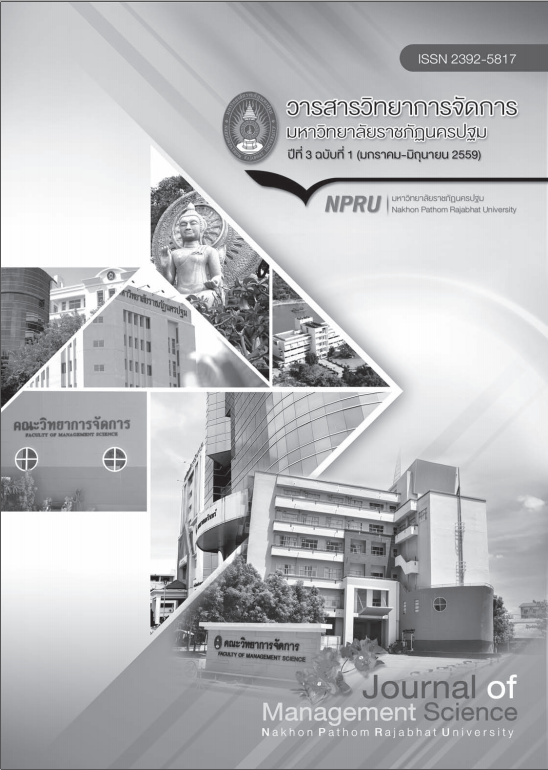Strategy to build brand image in the footwear industry in Thailand
Main Article Content
Abstract
The aim of Dissertation: (1) To study the concept of the Strategies to build the Brand Image of the footwear industry in Thailand (2) To study with the process in the Strategies to build the Brand Image of the footwear industry in Thailand 3) To study the indication of the factors that affects the Strategies to build the Brand Image of the footwear industry in Thailand.
In this study the researchers had mixed method. Using Quantitative research with Path analysis in model from clients who have used the product brand in the footwear industry in Thailand of 472 samples with depth interview. The questionnaire validated the accuracy of a panel of 5 experts. To calculate the IOC and reliability testing with a correlation with the Cronbach's alpha.
The results showed that the Strategies to build the Brand Image of the footwear industry in Thailand Influenced by the positive as well. Customer Loyalty (E = 0.77) elationship management with customers (E = 0.59) Integrated Marketing Communication (E = 0.35) to manage the marketing mix (E = 0.17) and the Trust of customers (.E = 0.08) was statistically significant, respectively.
Results of the research showed. Step the Strategies to build the Brand Image of the footwear industry in Thailand must use all elements together, it sort of communication between customers, employees package. This is the direction that needs to be communicated in the same direction. Creating a brand image requires continued innovation.
Article history : Accepted 29 January 2016
SIMILARITY INDEX = 0.00
Article Details
The views and opinions of the article appearing in this journal are those of the author. It is not considered a view and responsibility of the editorial staff.
References
เกศนภา ไลซานดร้า ยะเสน. (2553). ปัจจัยที่มีผลต่อระดับความจงรักภักดีของลูกค้าในการใช้สินค้าและบริการโทรศัพท์เคลื่อนที่ของบริษัท แอดวานซ์ อินโฟร์ เซอร์วิส จำกัด (มหาชน)ในเขตจังหวัดปทุมธานี. วิทยานิพนธ์บริหารธุรกิจมหาบัณฑิต, มหาวิทยาลัยรามคำแหง.
ฉัตยาพร เสมอใจ. (2549). การบริหารการตลาด. กรุงเทพมหานคร : ซีเอ็ดยูเคชั่น.
ชัยสมพล ชาวประเสริฐ. (2547). การตลาดบริการ. กรุงเทพฯ : ซีเอ็ดยูเคชั่น.
ธีรพันธ์ โล่ห์ทองคำ. (2552). รูปแบบกลยุทธ์การใช้เครื่องมือสื่อสารการตลาดเชิงบูรณาการในการบริหารคุณค่าตราสินค้าตามระดับความสำคัญของผลิตภัณฑ์. ดุษฎีนิพนธ์ปรัชญาดุษฎีบัณฑิต. มหาวิทยาลัยรามคำแหง.
รุ่งรัตน์ ชัยสำเร็จ.(2553). การเขียนเพื่อการประชาสัมพันธ์ .กรุงเทพฯ : สำนักพิมพ์แห่งจุฬาลงกรณ์มหาวิทยาลัย.
รุจาภา แพ่งเกษร. (2555). การบริหารการตลาด (Marketing Management). เอกสารประกอบการเรียนการสอนหลักสูตรบริหารธุรกิจมหาบัณฑิต. มหาวิทยาลัยรังสิต.
วิยะกานต์ ตันสุวรรณรัตน์. (2552). ปัจจัยที่มีผลต่อการตัดสินใจในการเลือกซื้อโทรศัพท์เคลื่อนที่ HOUSEBRAND ของผู้บริโภคในเขตกรุงเทพมหานครและปริมณฑล. รายงานการศึกษาค้นคว้าอิสระสาขาการตลาด. คณะบริหารธุรกิจ. มหาวิทยาลัยรังสิต.
ศิริวรรณ เสรีรัตน์และคณะ. (2550). พฤติกรรมผู้บริโภค. กรุงเทพฯ ธีระฟิล์มและไซเท็กซ์.
สมวงศ์ พงศ์สถาพร และสุนทร เลาหพัฒนวงศ์. (2550). CRMเกมครองใจลูกค้า. กรุงเทพมหานคร : ซี.พี.พริ้นท์เทค.
สุดาพร กุณฑลบุตร. (2550). หลักการตลาดสมัยใหม่. กรุงเทพฯ : จุฬาลงกรณ์มหาวิทยาลัย.
สุภาวดี ล้ำสกุลวงศ์. (2552). ปัจจัยที่มีผลกระทบต่อการตัดสินใจเลือกซื้อรถยนต์นั่งส่วนบุคคลยี่ห้อฮอนด้าของนักศึกษาปริญญาโทมหาวิทยาลัยเอกชนในเขตกรุงเทพมหานคร. รายงานการศึกษาค้าคว้าอิสระ.หลักสูตรบริหารธุรกิจบัณฑิต. สาขาวิชาการตลาด. คณะบริหารธุรกิจ. มหาวิทยาลัยรังสิต.
เสรี วงษ์มณฑา.(2541). ภาพพจน์นั้นสำคัญไฉน? .กรุงเทพฯ : บริษัท ธีระฟิล์มและไซเท็กซ์ จำกัด.
Kotler, Philip. (2000). Marketing Management. (10th ed.) New Jersey : Prentice-Hall.
Macer, D. R. J. (2000). Ethical challenges as we approach the end of the human genome project. New Mexico : Eubios Ethics Institute.
Pokorski, R . K. (1995). Genetic information and life insurance. Nature, 376, 13-28.
Sjoberg, L. (2002). Attitudes to technology and risk: Going beyond what is immediately given. Policy Sciences, 35, 379-400.


